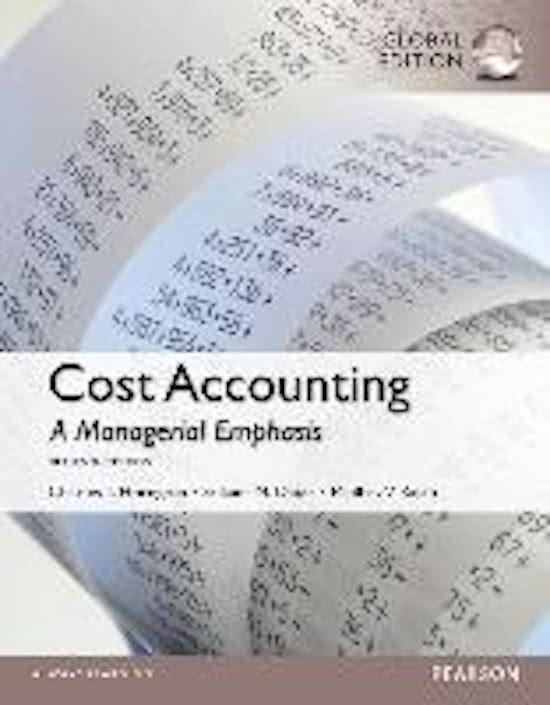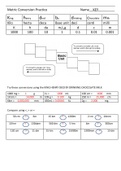CHAPTER 13
PRICING DECISIONS AND COST MANAGEMENT
13-1 The three major influences on pricing decisions are
1. Customers
2. Competitors
3. Costs
13-2 Not necessarily. For a one-time-only special order, the relevant costs are only those costs
that will change as a result of accepting the order. In this case, full product costs will rarely be
relevant. It is more likely that full product costs will be relevant costs for long-run pricing
decisions.
13-3 Four purposes of cost allocation are as follows:
1. To provide information for economic decisions
2. To motivate managers and other employees
3. To justify costs or compute reimbursement amounts
4. To measure income and assets
13-4 Activity-based costing helps managers in pricing decisions in two ways.
1. It gives managers more accurate product-cost information for making pricing decisions.
2. It helps managers to manage costs during value engineering by identifying the cost
impact of eliminating, reducing, or changing various activities.
13-5 Two alternative approaches to long-run pricing decisions are the following:
1. Market-based pricing, an important form of which is target pricing. The market-based
approach asks, “Given what our customers want and how our competitors will react to what we
do, what price should we charge?”
2. Cost-based pricing which asks, “What does it cost us to make this product and, hence,
what price should we charge that will recoup our costs and achieve a target return on
investment?”
13-6 A target cost per unit is the estimated long-run cost per unit of a product (or service) that,
when sold at the target price, enables the company to achieve the targeted operating income per
unit.
13-7 Value engineering is a systematic evaluation of all aspects of the value-chain business
functions, with the objective of reducing costs while satisfying customer needs. Value
engineering via improvement in product and process designs is a principal technique that
companies use to achieve target cost per unit.
13-8 A value-added cost is a cost that customers perceive as adding value, or utility, to a
product or service. Examples are costs of materials, direct labor, tools, and machinery. A
nonvalue-added cost is a cost that customers do not perceive as adding value, or utility, to a
product or service. Examples of nonvalue-added costs are costs of rework, scrap, expediting, and
breakdown maintenance.
,13-9 No. It is important to distinguish between when costs are locked in and when costs are
incurred because it is difficult to alter or reduce costs that have already been locked in.
13-10 Cost-plus pricing is a pricing approach in which managers add a markup to cost in order
to determine price.
13-11 Cost-plus pricing methods vary depending on the bases used to calculate prices.
Examples are (a) variable manufacturing costs; (b) manufacturing function costs; (c) variable
product costs; and (d) full product costs.
13-12 Two examples where the difference in the costs of two products or services is much
smaller than the differences in their prices are:
1. The difference in prices charged for a telephone call, hotel room, or car rental during
busy versus slack periods is often much greater than the difference in costs to provide these
services.
2. The difference in costs for an airplane seat sold to a passenger traveling on business or a
passenger traveling for pleasure is roughly the same. However, airline companies price
discriminate. They routinely charge business travelers––those who are likely to start and
complete their travel during the same week excluding the weekend––a much higher price for the
same class of service than pleasure travelers who generally stay at their destinations over at least
one weekend.
13-13 Life-cycle budgeting is an estimate of the revenues and costs attributable to each product
from its initial R&D to its final customer servicing and support.
13-14 Three benefits of using a product life-cycle reporting format are the following:
1. The full set of revenues and costs associated with each product becomes more visible.
2. Differences among products in the percentage of total costs committed at early stages in
the life cycle are highlighted.
3. Interrelationships among business function cost categories are highlighted.
13-15 Predatory pricing occurs when a business deliberately prices below its costs in an effort
to drive competitors out of the market and restrict supply and then raises prices rather than
enlarge demand. Under U.S. laws, dumping occurs when a non-U.S. company sells a product in
the United States at a price below the market value in the country where it is produced, and this
lower price materially injures or threatens to materially injure an industry in the United States.
Collusive pricing occurs when companies in an industry conspire in their pricing and production
decisions to achieve a price above the competitive price and so restrain trade.
,13-16 (25–30 min.) Value-added, nonvalue-added costs.
1.
Category Examples
Value-added costs a. Materials and labor for regular repairs $1,100,000
Nonvalue-added costs b. Rework costs $ 90,000
c. Expediting costs caused by work delays 65,000
g. Breakdown maintenance of equipment 75,000
Total $ 230,000
Gray area d. Materials handling costs $ 80,000
e. Materials procurement and inspection costs 45,000
f. Preventive maintenance of equipment 55,000
Total $ 180,000
Classifications of value-added, nonvalue-added, and gray area costs are often not clear-cut.
Other classifications of some of the cost categories are also plausible. For example, some
students may include materials handling, materials procurement, and inspection costs and
preventive maintenance as value-added costs (costs that customers perceive as adding value and
as being necessary for good repair service) rather than as in the gray area. Preventive
maintenance, for instance, might be regarded as value-added because it helps prevent nonvalue-
adding breakdown maintenance.
2. Total costs in the gray area are $180,000. Of this, we assume 60%, or $108,000, are
value-added and 40%, or $72,000, are nonvalue-added.
Total value-added costs: $1,100,000 + $108,000 $1,208,000
Total nonvalue-added costs: $230,000 + $72,000 302,000
Total costs $1,510,000
Nonvalue-added costs are $302,000 ÷ $1,510,000 = 20% of total costs.
Value-added costs are $1,208,000 ÷ $1,510,000 = 80% of total costs.
, 3. Effect on Costs Classified as
Value- Nonvalue- Gray
Program Added Added Area
(a) Quality improvement programs to
• reduce rework costs by 40% (0.40 $90,000) –$ 36,000
• reduce expediting costs by 40%
(0.40 $65,000) – 26,000
• reduce materials and labor costs by 5%
(0.05 $1,100,000) –$ 55,000
Total effect –$ 55,000 –$ 62,000
(b) Working with suppliers to
• reduce materials procurement and inspection costs by
20% (0.20 $45,000) –$ 9,000
• reduce materials handling costs by 30%
(0.30 $80,000) – 24,000
Total effect – 33,000
Transferring 60% of gray area costs (0.60
$33,000 = $19,800) as value-added and 40%
–$ 19,800 –$ 13,200 + 33,000
(0.40 $33,000 = $13,200) as nonvalue-added
–$ 19,800 –$ 13,200 $ 0
Effect on value-added and nonvalue-added costs
(c) Maintenance programs to
• increase preventive maintenance costs by 70%
(0.70 $55,000) +$38,500
• decrease breakdown maintenance costs by 50%
(0.50 $75,000) –$ 37,500
Total effect – 37,500 + 38,500
Transferring 60% of gray area costs (0.60 $38,500 =
$23,100) as value-added and 40% (0.40 $38,500 =
+$ 23,100 + 15,400 – 38,500
$15,400) as nonvalue-added
+$ 23,100 –$ 22,100 $ 0
Effect on value-added and nonvalue-added costs
Total effect of all programs –$ 51,700 –$ 97,300
Value-added and nonvalue-added costs calculated in
requirement 2 1,208,000 302,000
Expected value-added and nonvalue-added costs as a result of
implementing these programs $1,156,300 $204,700
If these programs had been implemented, total costs would have decreased from $1,510,000
(requirement 2) to $1,156,300 + $204,700 = $1,361,000, and the percentage of nonvalue-added
costs would decrease from 20% (requirement 2) to $204,700 ÷ $1,316,000 = 15%. These are
significant improvements in Magill’s performance.






